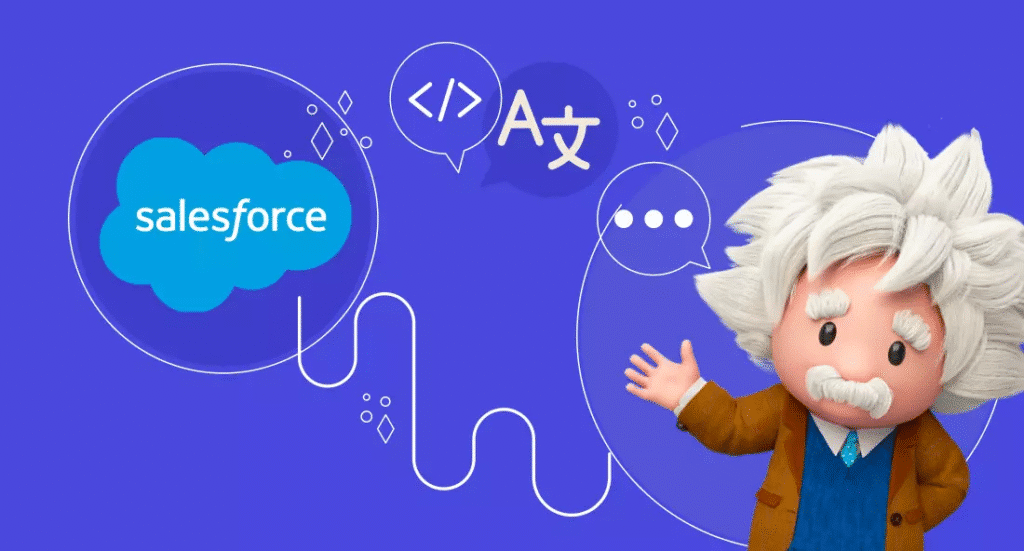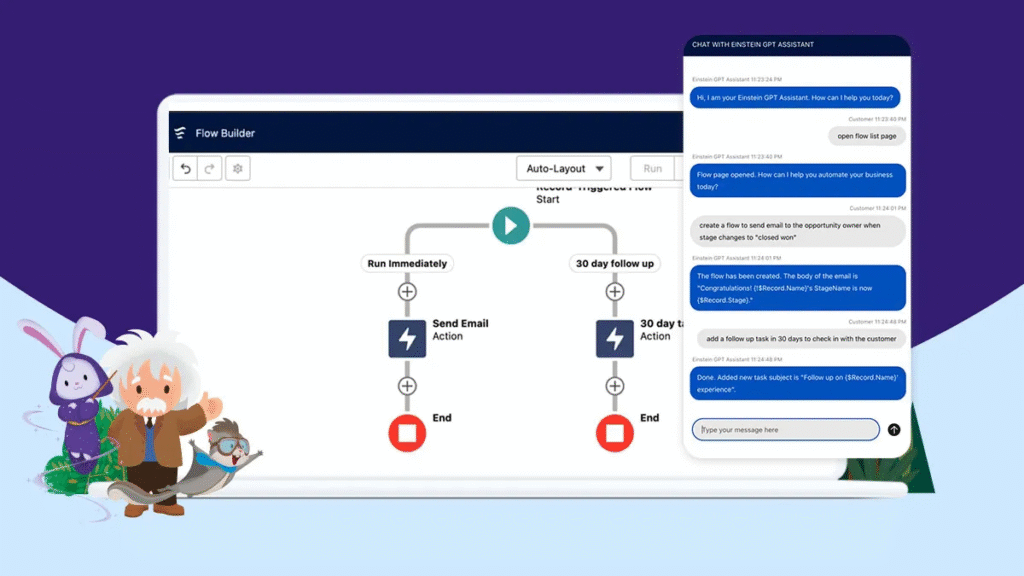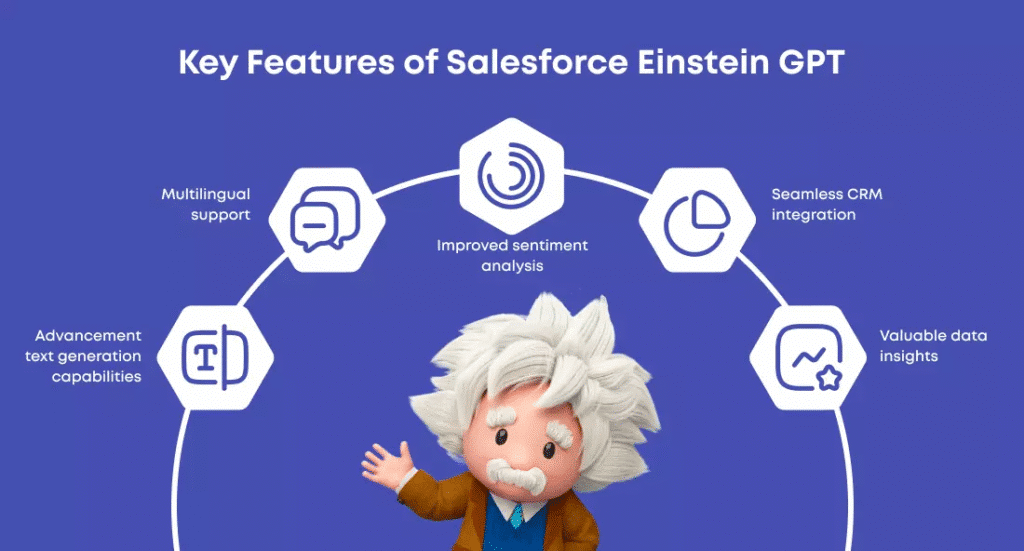Efficient business practices aren’t just a trendy word these days; they’re a must. Businesses are always looking for new ways to streamline their processes, automate tasks that they do over and over, and eventually boost their output. Strong process automation is often the answer for people who use Salesforce to its full potential. And now, a revolution that will completely change how we deal with this is on the horizon: Cloud Flow GPT in Salesforce.

Imagine a world where creating complicated, smart workflows isn’t a hard, code-heavy process but a conversation that everyone can understand. A world where you can use natural language to explain your business need, and a powerful AI will turn that into a fully working Salesforce Flow. This is not a dream version of the future; Flow GPT in Salesforce is making it a reality right now.
Table of Contents
ToggleThe Evolution of Automation in Salesforce: Workflow Rules to Flow
Before we get into how revolutionary Flow GPT could be in Salesforce, let’s take a quick look at how automation has been used in the Salesforce environment in the past.
Workflow Rules have been the best way to automate simple jobs for a long time. They were simple to set up but only let you do a few things, like change records, create tasks and send email alerts. The need for more powerful automation tools grew as business needs got more complex.
Enter Salesforce Flow. Flow changed automation by letting you build complicated business processes with just a few clicks instead of lines of code. Administrators and developers could use Flow to set up complex chains of actions that could update data, make records, get approvals and connect to other systems. A bigger group of people could use Flow because it had a canvas where business principles could be visually mapped.

But there was still a learning curve, even though Flow was very powerful. It could still take a lot of time to design complicated Flows, manage factors and deal with complicated logic, especially for people who are new to the platform, or have very specific, unique needs. This is where Flow GPT in Salesforce really shines as a game changer.
Key Benefits of Using Flow GPT in Salesforce
When Flow GPT is added to Salesforce, it helps companies, administrators and developers in many ways:
- Swift Workflow Development: The most clear benefit is how quickly workflows can be created. It takes a lot longer to go from an idea to a working system when natural language is turned into usable Flow. As a result, we can respond to business needs more quickly, and see the benefits of new projects more quickly.
- Increased Accessibility for Non-Developers: Salesforce Flow is already declarative, but Flow GPT in Salesforce reduces the entry barrier even more. Business users, analysts, and less technical administrators can now help create workflows by simply stating what they need. This gives more people the power to make processes better.
- Better quality and fewer mistakes: AI can find common mistakes, suggest the best ways to do things and make sure that the Flow logic that is created is strong and effective. This means there are fewer mistakes in the design, so there is less need for testing and redoing. In Salesforce, Flow GPT will act as a smart fence.
- Better productivity for experienced developers: Even developers and managers who have worked with Salesforce before will benefit a lot. They don’t have to start from scratch because they can use Flow GPT in Salesforce to make the basic logic. This lets them focus on adding features, customising their projects, and making plans for how to make them more difficult. You’ll feel like you have a helper who works incredibly hard.
- Faster optimisation and iteration: Businesses’ needs are always changing. It is much faster to change processes or make new ones with Salesforce’s Flow GPT as needs change. Because of this, businesses can quickly adapt to changes in the market and keep making their processes better.
- Gaining More Information: As Salesforce’s Flow GPT evolves, it may be able to examine present Flow patterns, identify issues, and recommend ways to improve things or uncover new ways to automate processes that human creators may not notice right away.
How Salesforce’s Flow GPT will transform several roles
Think about how this new technology will change the lives of different people in a Salesforce-using company:

For Salesforce administrators: Most of the time, admins save the day because they make sure that Salesforce runs smoothly and handle business requests. With Flow GPT in Salesforce, they can get more done.
- Setting up new automation quickly: You’ll be able to answer almost instantly to user requests like “Send a welcome email and assign a new lead from our website based on region.”
- Salesforce’s Flow GPT could help find problems in current Flows, offer fixes, or break down complicated logic for troubleshooting and debugging.
- Learning and upgrading your skills: Newer users can observe how Flow GPT in Salesforce creates solutions to learn best practices.
For Business Users and Analysts: There are times when business users know best what operations need but lack the technology skills to make it happen. This is filled by Salesforce’s Flow GPT.
- They can work with a boss using Flow GPT in Salesforce to explain what they need and quickly see their ideas come to life. This has a direct effect on automation.
- Making models of ideas: You can test automation ideas quickly and without spending a lot of money on hardware. Flows that are hard to understand can be made simple with the help of the natural language interface.
Salesforce Developers: Developers can write code effectively, but they also appreciate tools that make their jobs easier. In Salesforce, Flow GPT is not meant to take the place of hackers; instead, it gives them more power.
- Setting up the general structure for long flows with many steps frees up time for making complex Apex interfaces or UI components. When you follow best practices, you make sure that generated Flows follow Salesforce’s rules, even if it’s not a very common case.
- Focussing on new ideas: By automating routine Flow creation, developers have more time to work on brand-new concepts and intricate customisations that require creative thought.
The Future of Automation in Salesforce with Flow GPT
Once Flow GPT is added to Salesforce, companies will be able to do more things automatically. It shows that better, easier-to-use, and more open tools are on the way. These tools will let more people help with the digital change. It’s likely that this technology will get even better as time goes on:

- Multi-modal inputs: Instead of text, you could show Flow GPT in Salesforce a diagram or a short movie that explains a process.
- Proactive suggestions: The AI could look at how you use Salesforce and suggest new ways to automate tasks, or make current Flows better.
- Healing yourself Flows: If there is a mistake or a change in the underlying data models, Salesforce’s Flow GPT might be able to offer fixes, or even make them automatically.
- Better integrations: Using natural language commands, it is now even easier to connect Salesforce Flows to a huge community of outside apps, and services.
Getting Salesforce ready for Flow GPT
Even though Flow GPT in Salesforce is still a new technology, companies and managers can start getting ready for it right away:
- Learn more about Salesforce Flow: If you have a good idea of Flow concepts, it will be easier to use and tweak what Flow GPT in Salesforce makes.
- Get your Salesforce Org in order: Any automation tool needs clear items, fields and data that stays the same. AI-powered tools need this even more.
- Write down how your business works: For Flow GPT in Salesforce to make correct workflows, the best input will be processes that are clearly stated.
- Keep up with updates: Keep up with the latest news and best practices for Flow GPT in Salesforce by reading official Salesforce blogs, announcements and workshops.
When it comes to business automation, big changes are about to happen, and Flow GPT in Salesforce is at the front of the pack. It claims to give organisations around the world new levels of productivity, innovation and flexibility by making complex workflow creation easy to use, and quick. Get ready to make smart workflows in minutes, because Flow GPT in Salesforce is the next big thing in automation.
Bottom Line
Platforms like Mytutorialrack, run by Salesforce trainer Deepika Khanna, offer structured courses, real-world projects, and mentorship to help professionals master Salesforce solutions, such as Net Zero Cloud, and stand out as experts making a difference in the changing CRM landscape.






